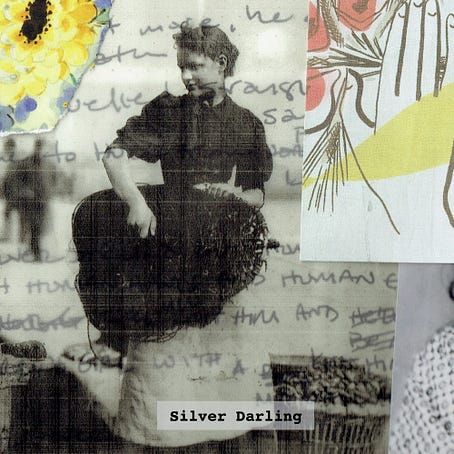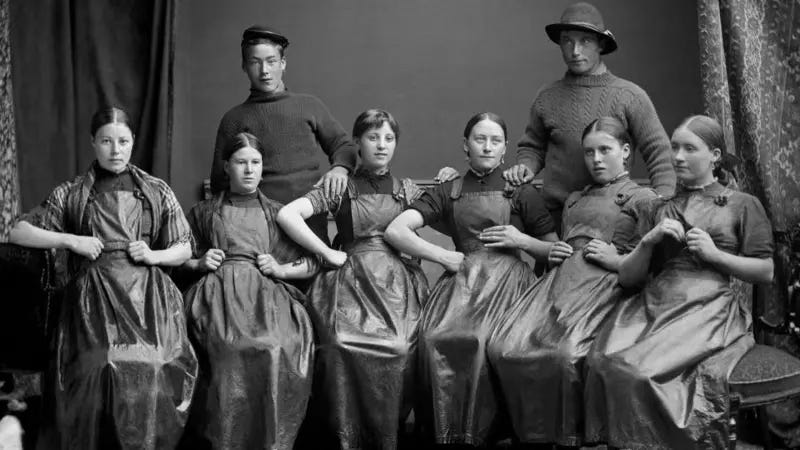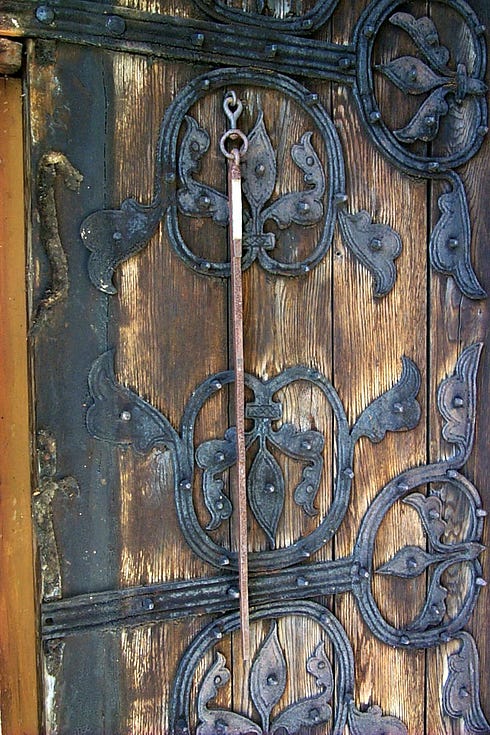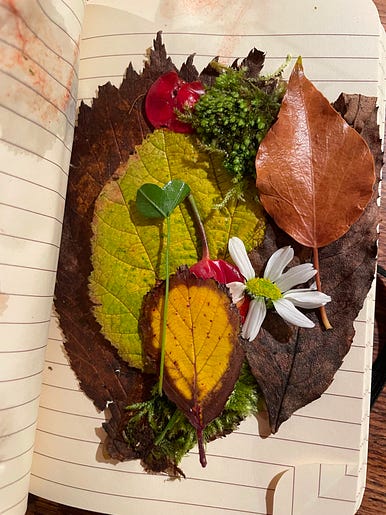Knit Him in Salt, Knit Him in Wind

This past week, Modern Daily Knitting released my article about ganseys – the working sweaters of the herring fleet in Britain. Read it here! I am so excited about this article because ganseys have a mythical place in my imagination.
As I say in the article, I became interested in ganseys after seeing my friend Angela Knipe knitting a little textured fish as she sat in the audience at one of my concerts. Years later, myriad influences converged and a fairytale song about ganseys came to me in a dream. To accompany the publication of my gansey article in MDK, I’ve created this annotated guide to my gansey and herring-inspired song “Silver Darling” from my album A Body is a Delicate House. Click play at the top of this letter to hear the song and following along with the lyrics.
Then, enjoy the annotations! If you’d like to know more about any of the lyrics, please comment below and I’ll answer.
Silver Darling by Jeni Hankins He fetched up from inky sea. He did not stir, he did not breathe. All unravelled, strangled on sand. Swept to Hull from a foreign land. A silver darling, but human-sized with human hands and human eyes. “I will knit him and knit him kind. Think a herring girl with a man all mine.” Knit him in salt, knit him in wind. And I’ll keep watch ’til he live again. I’m going over, my heart’s not free. My silver darling, will he love me? I flashed my needles in knit and purl. I spun him up neatly in wool. I swerved and danced and clicked my pins. I swarved and stitched for my fisherman. Row and furrow, garden to keep, hailstones, diamonds, and fine cat’s teeth, rope and ladder, hit and miss, all knit to win this darling’s kiss. Knit him in salt, knit him in wind. And I’ll keep watch ’til he live again. I’m going over, my heart’s not free. My silver darling, will he love me? And as he slept under my hap, a weaving watch all night I kept. Knit by knit, purl by purl, I charmed my darling back to this world. I gave him stockings and a gansey fine – to the nearest ell, made to his size. He donned his raiment well like a king. Now, I’m his girl, he my silver darling. Knit him in salt, knit him in wind. And I’ll keep watch ’til he live again. I’m going over, my heart’s not free. My silver darling, will he love me? Jeni Hankins – Vocals and Guitar Alfred John Hickling – All instruments except Craig Eastman – Fiddle and Slide Guitar Billy Hickling – Percussion Alison Moynihan Eastman – Harmony Vocals
He fetched up from inky sea./He did not stir, he did not breathe.¹
All unravelled, strangled on sand./Swept to Hull from a foreign land.²
A silver darling, but human-sized/with human hands and human eyes. ³
I will knit him and knit him kind./Think a herring girl with a man all mine.⁴
Knit him in salt, knit him in wind./And I’ll keep watch ’til he live again./I’m going over, my heart’s not free./My silver darling, will he love me.⁵
I flashed my needles in knit and purl./I spun him up neatly in wool….to the end of verse 2.⁶
And as he slept under my hap,/a weaving watch all night I kept…to the end of verse 3.⁷
He fetched up from inky sea./He did not stir, he did not breathe.
The Shakespeare play which I’ve seen more than any other is The Tempest and I have no doubt that these many performances crept into the first lines of my song. My sister, Sarah Hankins, is an actor, director, and teacher. I’ve seen her as Miranda and I’ve also seen her own production of The Tempest.
In The Tempest a group of men are shipwrecked on an enchanted island ruled by the sorcerer Prospero. There he protects his daughter Miranda from the advances of part man part monster Caliban and he commands a quixotic spirit named Ariel. The shipwrecked men include Prospero’s traitorous brother Antonio who ousted him from his throne. Antonio’s handsome son Ferdinand also washes up on shore. One thing leads to another, Miranda and Ferdinand catch sight of each other, and the play must magic its way toward a happy ending for these lovers and peace between the brothers.
For me, Miranda’s love for Ferdinand echos the love I saw expressed by my friend Fiona as she cared for her husband Norman my music mentor who had Parkinson’s disease and dementia. Because Fiona is a knitter, knitting becomes an act of healing and care in my song and ultimately knitting becomes kind of spell-making.
All unravelled, strangled on sand./Swept to Hull from a foreign land.
With the “unravelling,” I begin to introduce the idea of knitting – of making and unmaking.
My two characters are the “He” from the first line who is called “Silver Darling” at the start of verse two – perhaps part man, part fish, the Ferdinand character – and the narrator, the Miranda, the teller of this fairytale who we learn is the herring girl at the end of verse two.
Here in the last line of verse one, we discover he’s washed up on the east coast of England at Hull where she’s found him. In my article for MDK, you’ll learn that the herring fleet sailed from the Scottish islands down along the east coast of Britain where Hull was a major port. Hull was also where my friend Norman was born and lived for his whole life, so I chose to set my tale in his hometown. We don’t know where the “he” of my song is from except a “foreign land.” Historically, among the Scottish Isles and the north of England there’s been cultural and commercial interchange with Scandinavia – not to mention invasions and wars. So, perhaps our Silver Darling is Scandinavian, perhaps he’s Scottish and only seems “foreign” to this local girl.
 |
A silver darling, but human-sized/with human hands and human eyes
Herring girls (or also herring lassies) and fishermen called the herring “silver darlings.” I love the idea of such an affectionate name for the fish that brought their wages and made their way of life. The “he” that washed ashore is a kind of mythical being. Is he actually part man part fish? Is he just very fair-haired, fair-skinned, and covered in glittering sand, so that he appears to be silvery? This I don’t answer because that’s how fairytales are.
I will knit him and knit him kind./Think a herring girl with a man all mine.
Here’s where our heroine decides to revive our hero. Her magic, her healing is in her knitting. When the herring girls weren’t gutting and salting fish, they were knitting ganseys and stockings. Their reward was in seeing their menfolk and themselves warm and dry at their work. Our heroine hopes that if she can knit her Silver Darling back together, her reward will be his wholeness and his love.
Here again, I’m thinking of the tireless commitment of my friend Fiona to her husband Norman’s care. I’m thinking of the work that Ferdinand is made to do by Prospero to prove his devotion to Miranda. I was thinking back to the care my mom gave to my dad in his last months and years of life with leukemia. I thought particularly of a moment when Dad had been asleep and his t-shirt was soaked. I helped him into a clean and dry t-shirt. That was the one time I ever helped my dad dress.
Knit him in salt, knit him in wind./And I’ll keep watch ’til he live again./I’m going over, my heart’s not free./My silver darling, will he love me.
Salt, wind, and water were the constants of following the fish. Our heroine will use these elements to knit her darling back to life. “Going over” is a euphemism for capsizing and her heart is capsizing and becoming his as she cares for him. She commits to his care without knowing what the outcome will be. Will he revive? Will he love her in return?
I flashed my needles in knit and purl./I spun him up neatly in wool….to the end of verse 2.
Here we come to one of the major inspirations for this song! During lockdown, I read This Golden Fleece: A Journey Through Britain’s Knitted History by Esther Rutter. To say this book changed my life is an understatement! Through reading it and all of Clara Parkes’ knitting books, I developed such a compelling desire to knit that it practically hurt. I got some chunky wool and just started knitting garter stitch with the vague idea of turning four squares into a sweater. I’d learned to knit about fifteen years earlier but never knitted beyond simple scarves. But here were things to which I could aspire – a gansey, patterned black and white gloves, and a life replete with wool. I could be part of the fold.
Little by little, I crashed through instructions, broke impossibly small wooden needles, made an accidentally very large sock, and filled drawers with yarn. I dyed yarn with avocados, onion skins, and leaves from local ferns. I became slightly mad and had to see and read about everything to do with Shetland, Fair Isle, crofting, sheep, and dye-rich lichens. This is how I started writing for Modern Daily Knitting. And in doing so, I went to many of the places Esther mentions in her book. You can read more about the Dales Countryside Museum here and about those black and white gloves here.
In This Golden Fleece, Esther describes the terrible knitters of Dent in the Yorkshire Dales who were rumored to have “swarved” as they knitted. This seems to be a rhythmic kind of swaying which accompanied their clicking “pins” – pins being another name for knitting needles. Esther also listed many of the patterns in ganseys which just wanted to be song lyrics so much that they wouldn’t let me rest – “Row and furrow, garden to keep,/hailstones, diamonds, and fine cat’s teeth,/rope and ladder, hit and miss.” From Esther I first learned the story of the herring girls then I found more resources like Knitting the Herring.
And as he slept under my hap,/a weaving watch all night I kept…to the end of verse 3.
Knitter and native Shetlander Ella Gordon describes a hap this way: “a traditional Shetland shawl with a square middle, 4 trapezium borders and a lace edging. Something women in Shetland wore for centuries – often as a coat, and to wrap their babies.” On her blog, Ella includes this photo of haps being stretched (also called “blocking” after knitting and washing and before wearing).
Our heroine’s last act of care is to wrap her darling up in her hap. Will it be a shroud or a chrysalis? I use the word “ell” to describe a measure of cloth which I learned from Esther. Wikipedia gives a beautiful description of the “ell” which comes from the word for “arm” and thus where we find ourselves with an “ell-bow”: “An ell-wand or ellwand was a rod of length. An ell was used for an official measurement [of cloth]. Edward I of England required that every town have one {ell-wand}. In Scotland, the Belt of Orion was called “the King’s Ellwand.” An iron ellwand is preserved in the entrance to Stånga Church on the Swedish island of Gotland, indicating the role that rural churches had in disseminating uniform measures.”
I feel we should organize a field trip to Stanga Church immediately and measure our own selves against the ellwand.
But for now, we can revel in this photo.
 |
In the end, our heroine’s lovingly knitted gansey fits the shipwrecked sailor and she wins his heart through her knitting of this garment and of his body and spirit back to health.
I wish that I could have done more than change my dad’s shirt. I know Fiona wishes she could have done more than watch as Norman unravelled scarves and became more and more quiet. Our heroine was blessed as those in fairytales can be, but in a way that those of us in real life often aren’t. Dad and Norman are playing banjo and mandolin together in the stars now. “They went to the meeting with their old coat on and came home with a new one on.” Their worry’s all gone.
I based the melody of “Silver Darling” on Jake and Sarah Owen’sversion of the traditional song “The Butcher’s Boy” also known as “The Railroad Boy.” Their reading of this song is called “Snow Dove” and Dad and I worked out a banjo part for it many years ago. As I was thinking about the lyrics that old melody came back to me. I often write on banjo or dulcimer, but then switch to my main instrument, guitar, for performance. I like how instruments that aren’t as straightforward for me, encourage me to stretch my songwriting.
Thank you for reading along. I hope you’ve enjoyed learning about the pattern of this song and how I created this story. One last thing I’ll say is that the annotations can give the impression that this song was built from research line by line, but actually it came to me in a dream and I had to scratch it down on paper in the middle of the night. Often what happens with my songs is that I take in a huge amount of information and impressions sometimes over the course of years and, one day (or one night), my cup gets full and the song spills over into my voice and guitar. It’s only when looking back at a song through a magnifying glass that I can see all of those pieces that I was collecting all along.
With kindness,
Jeni
P.S. My friend Angela who knitted gansey patterned fish brooches for years is digitizing her handwritten patterns! I’ll be testing them for her. So excited. In the meantime, if you’d like to knit a silver darling, you can find a pattern here at Knitting the Herring.
I miss the quiet encouragement in Norman eyes as he sat and watched dozens of my concerts. His faith in my ability to carry on the folk traditions he loved buoys me as I continue to write songs. Thank you, Norman. If you’d like to hear two other songs I’ve written about my friend Norman, you can listen to “Last Time I Changed These Strings” on YouTube and you can read the story and listen to the song “String Unraveller.” Like “Silver Darling” these songs feature musician Alfred John Hickling.
Tip Jar at Paypal or Ko-Fi. Thank you for supporting the new song, dolly rescue, bear rehabilitation, and loom re-stringing society!
Substack Notes where I post pictures and thoughts plus excerpts from other writers whose work I’m enjoying.
My shop where you can buy real albums that you can hold in your hand. Albums for the USA and Canada ship from the USA. Albums for the UK and Europe ship from the UK. Everywhere else, please write to me first! What chaos, the tariffs!
My website. And my tour page with dates currently being added.
Instagram and Facebook where I post my adventures almost daily.
My articles for Modern Daily Knitting.
Paid subscribers receive a link to download a new song each month.




Comments
Post a Comment
Thank you for your comment! The lovely moderator will attend to it gently and promptly.